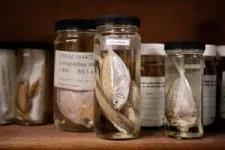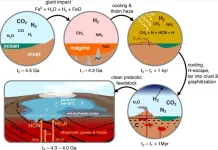(Press-News.org) A new urine test that measures 18 genes associated with prostate cancer provides higher accuracy for detecting clinically significant cancers than PSA and other existing biomarker tests, according to a study published April 18 in JAMA Oncology. The urine test, MyProstateScore 2.0 (MPS2), was shown to meaningfully reduce unnecessary prostate biopsies while providing highly accurate detection of worrisome prostate cancers, the researchers concluded.
“In nearly 800 patients with an elevated PSA level, the new test was capable of ruling out the presence of clinically significant prostate cancer with remarkable accuracy. This allows patients to avoid more burdensome and invasive tests, like MRI and prostate biopsy, with great confidence that we are not missing something,” said Jeffrey Tosoian, MD, assistant professor of Urology and director of Translational Cancer Research at Vanderbilt University Medical Center, who is first author of the study.
Prostate cancer is the most common cancer and the second leading cause of cancer death among men in the U.S. The PSA blood test has been widely used as the initial step in prostate cancer screening. Although PSA is elevated in the vast majority of men with prostate cancer, it is also elevated in a significant proportion of men without cancer.
As a result, the use of elevated PSA alone to prompt a prostate biopsy results in numerous unnecessary biopsies. Although generally safe, prostate biopsies are invasive, uncomfortable, and carry some risk of worrisome complications. Therefore, for patients with an elevated PSA, there is a great need for a second-line test to better identify which men truly need a biopsy and which do not.
Because some low-grade, prostate cancers do not require treatment and can be safely monitored with an approach termed active surveillance, the MPS2 test was developed to detect more specifically the higher-grade, “clinically significant” cancers in need of early detection and treatment. To do this, the research team analyzed prostate tumors from across the U.S. to identify novel genes more often detected in the presence of significant cancers. The most informative 18 genes were combined into the MPS2 test, which was then tested in a National Cancer Institute trial of men with an elevated PSA level. Uniquely, the authors were able to compare the novel test to other prostate cancer tests, including the original, two-gene MPS test.
The study involved 743 men with a median age of 62 years and a median PSA level of 5.6. While existing biomarker tests could have avoided 15% to 30% of unnecessary biopsies (i.e. biopsies that were negative or found low-grade cancers not requiring treatment), use of MPS2 would have avoided 35% to 42% of unnecessary biopsies without missing any additional diagnoses of clinically significant cancer. The improvement was even more pronounced in men with a history of a previous negative biopsy, reducing the rate of unnecessary biopsies from 46% to 51% with use of MPS2, as compared to 9% to 21% for existing tests.
Multiparametric magnetic resonance imaging (mpMRI) is another second-line test that has been utilized, but while it can improve detection of clinically significant prostate cancer, interpretation of the results can be subjective and vary significantly. The authors also noted that mpMRI is not available in some community settings and is not an option for some patients. The current study was not designed to compare biomarkers to mpMRI, but the researchers are currently conducting a prospective, multicenter trial for that purpose.
In patients shown to be without clinically significant prostate cancer by the new test, the authors concluded that the “externally validated performance of MPS2 supports its effectiveness in accurately ruling out the need for mpMRI and biopsy altogether.” They noted a limitation of the study was that only 13% of participants were African American. Because prostate cancer is more prevalent among African American men, the research team is currently pursuing further analyses in more racially diverse populations.
Tosoian is co-first author with Yuping Zhang, PhD, and Lanbo Xiao, PhD, professors at the University of Michigan, where Tosoian and Arul Chinnaiyan, MD, PhD, initiated the study. Chinnaiyan and John T. Wei, MD, are the study’s senior authors. Other Vanderbilt researchers who contributed to the study are Nathan Samora, MD, and Hunter Robinson, MD.
The study received funding support from the Prostate Cancer Foundation Young Investigator Award (Tosoian), Michigan-Vanderbilt EDRN Biomarker Characterization Center (U2C CA271854), and the EDRN DMCC (U24 CA086368).
END
Milan, April 17 2024 – The study, published in Nature Energy, is among the first to explore the FPV at the continental scale, finding that FPV installed at existing major reservoirs could produce 20-100% of the electricity expected from Africa’s planned hydropower dams. Using a state-of-the-art energy planning model covering the continent’s entire energy system, the researchers found that FPV is cost-competitive with other renewables and thus a key part of Africa’s future energy mix.
"Floating solar is fast becoming cost-competitive with land-based solar, and ...
Scientists in Cambridge University suggest molecules, vital to the development of life, could have formed from a process known as graphitisation. Once verified in the laboratory, it could allow us to try and recreate plausible conditions for life's emergence.
How did the chemicals required for life get there?
It has long been debated how the seemingly fortuitous conditions for life arose in nature, with many hypothesises reaching dead ends. However, researchers at the University of Cambridge have now modelled how these conditions could occur, producing the necessary ingredients for life in substantial ...
A geo-environmental scientist from Japan has composed a string quartet using sonified climate data. The 6-minute-long composition—entitled “String Quartet No. 1 “Polar Energy Budget”—is based on over 30 years of satellite-collected climate data from the Arctic and Antarctic and aims to garner attention on how climate is driven by the input and output of energy at the poles. The backstory about how the composition was put together publishes April 18 in the journal iScience as part of a collection “Exploring the Art-Science Connection.”
“I strongly hope that this manuscript marks a significant turning point, transitioning ...
A new ancient species of snake dubbed Vasuki Indicus, which lived around 47 million years ago in the state of Gujarat in India, may have been one of the largest snakes to have ever lived, suggests new research published in Scientific Reports. The new species, which reached an estimated length of between 11 and 15 metres, was part of the now extinct madtsoiidae snake family, but represented a distinct lineage that originated in India.
Debajit Datta and Sunil Bajpai describe a new specimen recovered from the Panandhro Lignite Mine, Kutch, Gujarat State, India, which dates ...
About The Study: The findings of this study with 322 participants suggest that racial discrimination predisposes Black young adults to metabolic syndrome via sleep problems and inflammation, which may serve as actionable targets for prevention in minoritized populations that could reduce existing disparities and promote health equity.
Authors: Nia Heard-Garris, M.D., M.B.A., M.Sc., of the Northwestern University Feinberg School of Medicine in Chicago, is the corresponding author.
To access the embargoed study: Visit our For The Media website at this link https://media.jamanetwork.com/
(doi:10.1001/jamanetworkopen.2024.5288)
Editor’s Note: Please ...
About The Study: In this cross-sectional study using data from the Behavioral Risk Factor Surveillance System for 10,000 cancer survivors, only 4% of cancer survivors adhered to all four American Cancer Society nutrition and physical activity guidelines, with the mean number of guidelines met being 2.0. Improved understanding of guideline adherence and its determinants may guide oncologists and general internists in providing recommendations for their patients who have completed cancer treatments.
Authors: Kathryn Norman, M.D., of the Beth Israel Deaconess Medical Center in Boston, is the corresponding author.
To access the embargoed study: Visit our For The ...
ANN ARBOR, Michigan — Researchers at the University of Michigan Rogel Cancer Center have developed a new urine-based test that addresses a major problem in prostate cancer: how to separate the slow-growing form of the disease unlikely to cause harm from more aggressive cancer that needs immediate treatment.
The test, called MyProstateScore2.0, or MPS2, looks at 18 different genes linked to high-grade prostate cancer. In multiple tests using urine and tissue samples from men with prostate cancer, it successfully identified cancers ...
Findings of substantial variability in pathology AI models’ performance based on race, insurance type and age group serve as a “call to action” to researchers and regulators to improve medical equity
Large foundation models that incorporate a richer level of detail may mitigate disparities between different demographic groups and enhance model accuracy.
Advanced artificial intelligence (AI) systems have shown promise in revolutionalizing the field of pathology through transforming the detection, diagnosis, and treatment of disease; however, the underrepresentation of certain patient populations in pathology ...
Making ever smaller and more powerful chips requires new ultrathin materials: 2D materials that are only 1 atom thick, or even just a couple of atoms. Think about graphene or ultra-thin silicon membrane for instance. Scientists at TU Delft have taken an important step in application of these materials: they can now measure important thermal properties of ultrathin silicon membranes. A major advantage of their method is that no physical contact needs to be made with the membrane, so pristine properties can ...
A new study published in the scientific journal Addiction has found that people who are maltreated as children may be three times more likely to be admitted to hospital for alcohol and substance use disorders by the age of 40, compared with those who are not maltreated.
The study used data from over 6,000 children born at the Mater Mothers Hospital, Brisbane, Australia between 1981 and 1983. Ten percent of those children (609 children) had at least one child maltreatment notification (reported or substantiated) up to 15 years of age. Compared with the rest of the children, those 609 ...





